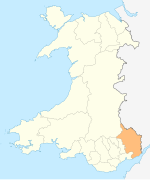Llanover

Llanover (/ləˈnoʊvə/; Welsh: Llanofer; Welsh pronunciation: [ɬaˈnɔvɛr]) is a village in the community of Goetre Fawr in Monmouthshire, Wales.
Name[edit]
The name of the village derives from an earlier Welsh form Llanfyfor, made up of llan 'enclosure, church' and the personal name Myfor.[1]
Location[edit]
Llanover is located four miles south of Abergavenny just off the A4042 road to Pontypool. The community includes the separate hamlets of Llanfair Kilgeddin, Llanfihangel Gobion, Llanddewi Rhydderch and The Bryn (a.k.a. Llangattock Nigh Usk).
Governance[edit]
An electoral ward exists in the same name. This ward includes the parish of Llanarth and elects a county councillor to Monmouthshire County Council.[2] The total ward population at the 2011 census was 2,284.[3] There was formerly a community called "Llanover", in 2022 its boundaries changed so that the village of Llanover became part of Goetre Fawr and the community of "Llanover" was renamed Gobion Fawr.[4] The population taken at the 2011 census was 1,392.[5]
History & amenities[edit]

Llanover is an estate village associated with the Hall family. Augusta Lady Llanover lived locally all her life and left her mark on the village and the surrounding Llanover House estate which remains privately owned. Her husband Sir Benjamin Hall became Baron Llanover. Her sisters, diplomatic hostess and author Frances Bunsen and Emily grew up there, educated by their mother Georgina Mary Ann, (née Port) (1771–1850), with Augusta and Frances surviving to become co-heiresses to the estate from their father Benjamin Waddington.[6] Llanover House was demolished in 1936 but the park survives relatively intact and is designated at Grade II* on the Cadw/ICOMOS Register of Parks and Gardens of Special Historic Interest in Wales.[7]
St Bartholomew's Church, Llanover is a grade II* listed building.[8] The River Usk flows close by, and to the west lies the Brecon and Monmouthshire canal, a scenic recreational boating route. More recently, Llanover is the birthplace of Penelope Fillon, the wife of François Fillon, former Prime Minister of France and candidate in the 2017 French presidential elections.
References[edit]
- ^ Morgan, Richard (2005). Place-names of Gwent. Llanrwst: Gwasg Carreg Gwalch. p. 136. ISBN 978-0-86381-956-8. OCLC 61528464.
- ^ The County of Monmouthshire (Electoral Changes) Order 2002. Statutory Instruments. 6 December 2002. Retrieved 1 January 2019.
{{cite book}}:|website=ignored (help) - ^ "Ward population 2011". Archived from the original on 7 April 2015. Retrieved 3 April 2015.
- ^ "The Monmouthshire (Communities) Order 2021". legislation.gov.uk. Retrieved 21 May 2022.
- ^ "Parish population 2011". Retrieved 3 April 2015.
- ^ "Bunsen, Christian Karl Josias von, Baron von Bunsen in the Prussian nobility (1791–1860), diplomatist and scholar hostess and biographer". Oxford Dictionary of National Biography (online ed.). Oxford University Press. 2004. doi:10.1093/ref:odnb/53760. ISBN 978-0-19-861412-8. Retrieved 31 May 2021. (Subscription or UK public library membership required.)
- ^ Cadw. "Llanover Park (PGW(Gt)41(MON))". National Historic Assets of Wales. Retrieved 6 February 2023.
- ^ Cadw. "Church of St Bartholomew, Llanover (Grade II*) (1992)". National Historic Assets of Wales. Retrieved 6 February 2023.
External links[edit]
51°46′N 2°59′W / 51.767°N 2.983°W

